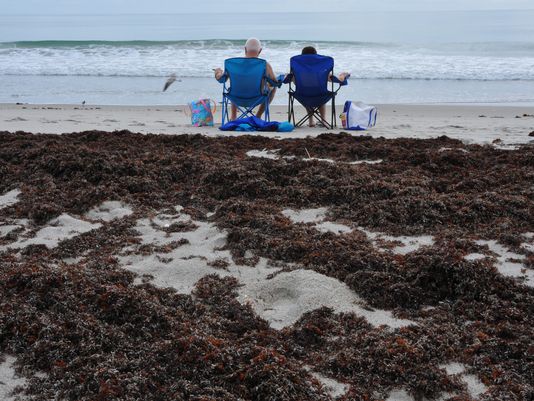Above: A couple enjoys the beach at the Patrick Air Force Base beach just north of Pineda Causeway, with mounds of seaweed piled on the beach behind them. (Credit: Malcolm Denemark/Florida Today)
The twisted, brown mess carpeting Space Coast beaches this week could be too much of a good thing gone awry.
And no one knows why.
Massive amounts of the open-ocean algae — called Sargassum — has been annoying anglers along the eastern United States. A similar widespread explosive growth of the stuff clogged up fisheries, shorelines and tourism in 2011.
Biologists aren’t sure why so much of the plant grew then, or now.
“From the Caribbean all the way to Massachusetts,” Mitch Roffer, president of Roffer’s Ocean Fishing Forecasting Service, Inc., said of the seaweed’s spread.
“This is the second episode where it appears there is something going on hemispherically. It’s been going on for months.”
Fishermen have had to give up on certain areas after they kept reeling in clumps of the algae, Roffer said.
Scientists have been studying the algae’s spread, as well as the 2011 event, but have yet to pin down causes.
“This has been going on for a couple of years,” said Brian LaPointe, a biologist at FAU-Harbor Branch Oceanographic Institute in Fort Pierce. “One hypothesis is climate change. These are tropical plants.”
A warming ocean surface might be allowing the plant to proliferate to a wider range.
Another theory points to wastewater and other coastal pollution supplying nutrients for the algae to grow.
“Temperature alone can’t make more biomass,” LaPointe said.
One theory about the 2011 extreme Sargassum growth in the Gulf of Mexico pins some of the blame on the BP Deepwater Horizon blowout in 2010. As the oil from the spill broke down, it released nutrients that fueled the algae.
Huge Sargassum blooms have hit the east coast of Barbados and Puerto Rico this month, blanketing coastal waters and beaches.
This week, large mats of the algae rolled up on Brevard County Beaches.
Most of the beach’s so-called “wrack line” is Sargassum, which mostly drifts in long lines near the Gulf Stream and provides vital food for young sea turtles. On the beach, the algae serves as fodder for crabs, beetles and other small creatures, which in turn are food for shorebirds.
The wrack line is also important for collecting wind-blown sand and encouraging plants, which help hold dunes in place to protect property.
Sargassum is a constant presence in the Atlantic, so much so that a large swath of the North Atlantic is known as the Sargasso Sea. Experts say sustained winds combined with seasonal shifts in the Gulf Stream probably are responsible for the sudden abundance on local beaches.
Brevard County lifeguards described a thick seaweed mess along the coast Monday, especially on Cocoa Beach, Cape Canaveral and Satellite Beach.
Local governments generally rake beaches for litter, avoiding the wrack line.
“We try to educate the people about it,” Cocoa Beach Public Works Director Bob Torres said Monday. “I’ve been to other beaches that are raked. To me, they almost look sterile.”
While unsightly and smelly for a few days, the benefits outweigh those drawbacks, Torres said.
“Generally, nature brings it in and nature brings it back out, too,” he said.
Any mechanized raking of the wrack line requires a state permit. And generally, heavy equipment isn’t allowed on the beach during sea turtle nesting season, which runs May through the end of October for most of Florida.
This article is re-posted from Florida Today October 2, 2014 – please click HERE for original article.






